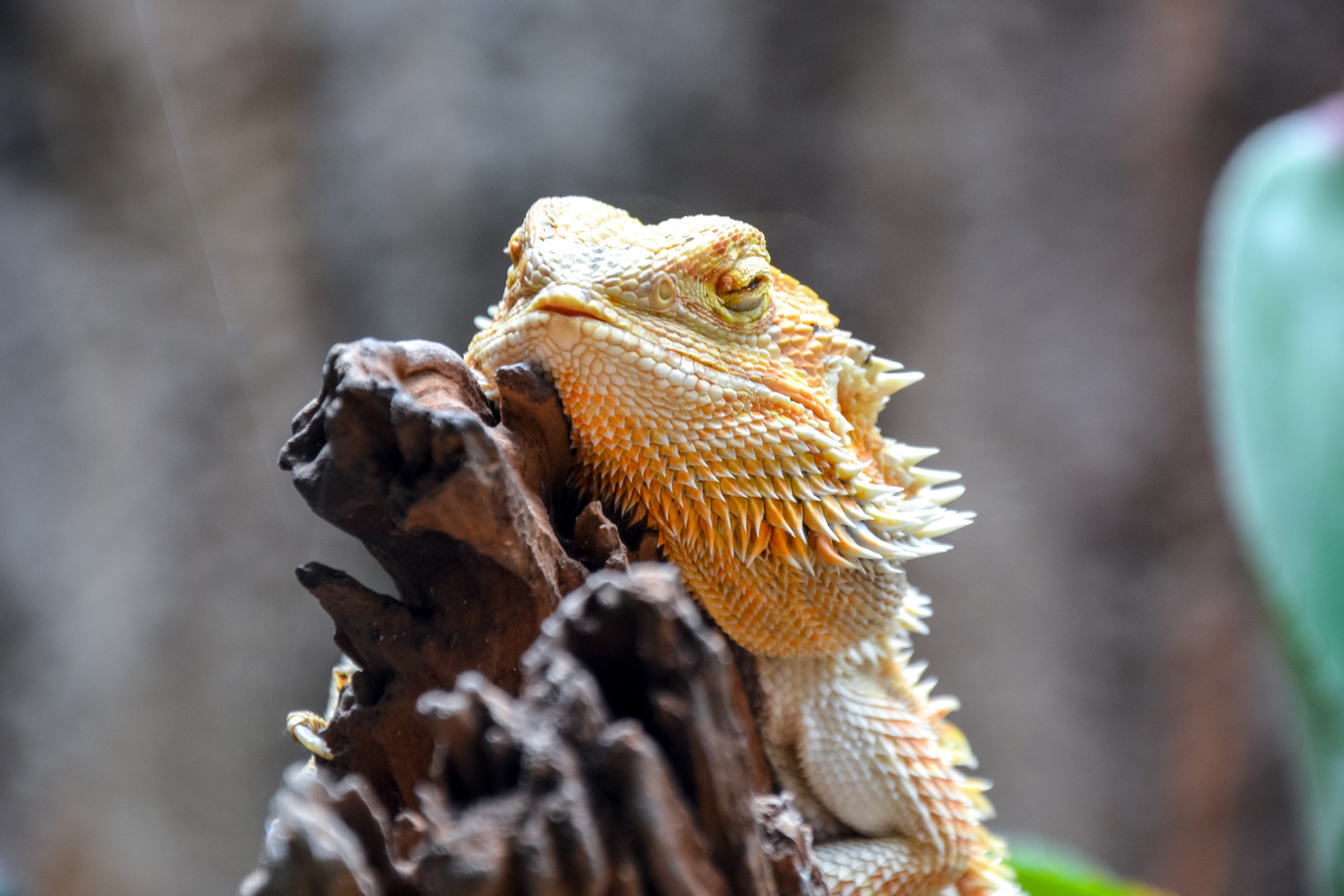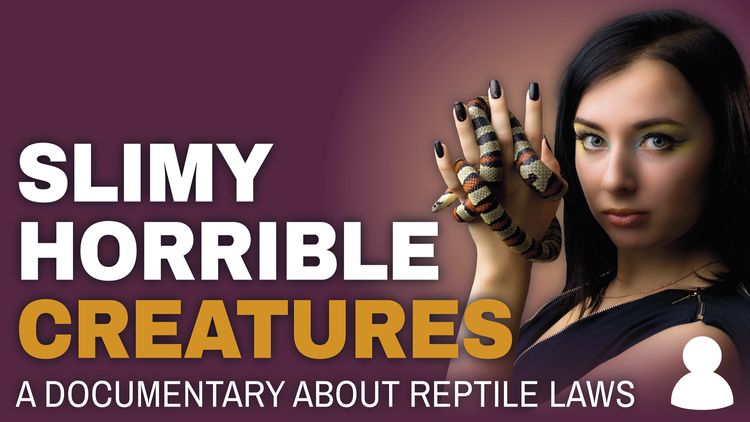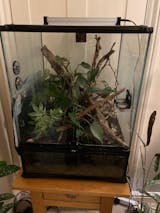Shopping List
- Wooden Vivarium - Minimum Size 120x60x60cm (regardless of age)
- High Output 12% T5 UVB Lighting Kit
- Basking Lamp - 75w Halogen or 100w Spot Lamp
- Fitting and Guard for Basking Lamp
- Dimming Thermostat
- Food and Water Bowls
- Decoration
- Specialist Bearded Dragon Substrate
Take the guess work out of compatibility with our ready made bearded dragon starter kits.
Introduction
Our care sheet covers the Inland Bearded Dragon (Pogona vitticeps) which is the most common species kept in captivity. Originating from Australia, these charismatic lizards can grow as large as 60cm including their tails and have a typical lifespan of 8-12 years with some living even longer.
With a stunning range of colours and patterns available, beginner and advanced keepers get equally excited about bearded dragons. They are easy to handle, rarely bite or nip and are known for being more tolerant of conditions that are not absolutely perfect then more delicate species.
Despite being one of the most widely kept and popular pet reptiles, they are sadly also one of the most widely misunderstood. The truth is that bearded dragons need a lot of space and are relatively expensive to setup and care for correctly. Taking shortcuts will almost always end up costing more in the long run so it is critical to ensure your setup is right from the start.
For keepers wiling to do the research, invest in the proper setup and understand fully the committment that comes with keeping a pet bearded dragon, there are few reptiles as rewarding or able to give as much back to their keepers, in terms of personality and interaction.
Selecting a Bearded Dragon
As Bearded Dragons originate from Australia (which allows no export of their native wildlife), all of the bearded dragons that you see for sale in the UK are captive bred. Unfortunately this does not mean that all the dragons offered for sale are equal in terms of quality and health.
It cannot be emphasised enough that you should never purchase a bearded dragon (or setup) on impulse; you will likely spend much more in the long term if you do. Instead do thorough research first and when fully informed purchase a new bearded dragon from a responsible breeder/reptile specialist or consider rehoming or adopting an older dragon.
Juveniles
Most responsible UK breeders no longer breed 'normal' bearded dragons, instead opting to breed 'higher end' dragons which attract a slightly higher price tag. This approach helps ensure there is a value attached to each bearded dragons which helps reduce impulse purchasing and the ideas that these are a cheap or disposal pet. Equally importantly it helps cover the costs assocaiated with raising a strong, healthy, happy baby bearded dragon which will thrive in its new home.
As we've already mentioned, looking after a bearded dragon is an expensive affair so paying a little more for the right bearded dragon will soon seem insignificant once you start paying the for the food and electricity your new pet requires.
A good breeder or store will not let a dragon leave until it is 8-12 weeks old and will never offer or encourage you to buy 2 or more dragons to live together. They should be able to talk to you about all aspects of care, supplementation, gutloading and always insist on seeing photograhic evidence of a setup before allowing you to take your new dragon home. Never take offense to this as the intention is to ensure your dragon will continue to thrive.
Rehoming
If you don't specifically want a young dragon or mind about genetics or morphs, then why not consider taking on a bearded dragon in need of rehoming? Given the number of incorrect setups still being sold by irresponsible stores or owners, the most common reason for people giving up with their pets is that they have realised the extent of the investment needed to put it right... this does unfortunately mean that the setups that often come with these dragons - especially the UV lights - are wholly unfit for purpose and will need replacing.
Rehoming should not be considered a budget route to owning a bearded dragon, it can in fact become very expensive if there are underlying health issues that need to be addressed. Therefore we'd always recommend speaking to a dedicated rehoming centre, reptile specialist or group about dragons they have (or are aware of) that need rehoming instead of deciding to source a dragon yourself via general pets for sale sites or groups found online.
Housing
Bearded dragons are solitary animals and will not benefit from being kept in pairs or groups; in fact this will likely cause undue stress and fighting can occur at any time without warning (even amongst individuals that have peacefully cohabited for long periods of time in the past). Whilst clutchmates are often kept together for a short period of time by breeders, as soon as a dragon is old enough to go to its new home it should be kept alone to ensure the best quality of life.
In most home environments we recommend the use of a wooden vivarium to help maintain the required temperatures your dragon needs. The generally accepted minimum vivarium size for a bearded dragon is 4'x2'x2' (120x60x60cm) but providing a larger space can only benefit and improve the quality of life for your dragon. The most popular enclosures we sell for bearded dragons are the Vivexotic Beard Dragon Vivarium, the Monkfield 4'x2'x2' and 5'x2'x2' vivariums; well built, available in a wide range of colours and available with optional matching cabinets they also blend in as attractive pieces of furniture at home.
We stongly advise against the the suggestion that you 'buy a smaller vivarium for now and upgrade later'. Bearded dragons grow extremely quickly and a larger setup will be necessary in a matter of weeks or months. Not only would this approach be a waste of money, it will also prove more difficult to set up the correct temperature gradient in a smaller vivariums due to their tendancy to over heat more quickly.
If you are told your dragon will stress or not feed in a larger environment this is simply not true - the moment a healthy bearded dragon is old enough to be sold and go to its new home, he or she is old enough to live in a large vivarium and will use every inch of the space provided - especially during their more active juvenile stage.
Heating
Daytime Heat
Heating is best provided from above using a thermostatically controlled basking bulb; this will replicate the warmth from the sun and heat the ground below creasting a "basking spot". The use of a bulb will also help to increasing the overall ambient air temperature within the vivarium. Spot bulbs - such as the Arcadia Solar Spot we include in all our starter kits - have in built reflectors which help direct the heat exactly where it is needed. Simply use these in conjunction with quality ceramic fittings (never plastic or household fittings) along with a mesh guard to ensure maximum safety.
Aim to acheive a basking area directly underneath the bulb (a hot spot) of around 40-42 degrees celsius - this should always be regulated and controlled using a quality dimming thermostat. As long as your dragon is housed in an appropriately sized vivarium it will be possible to create a good temperature gradient in the rest of the vivarium which in turn allows your dragon to escape the heat and cool down when it chooses.
Leave the basking bulb on for between 12-14 hours per day and then turn off completely at night time allowing your dragon to have uninterupted sleep.
Tip: use a smart thermostat such as a Microclimate Evo to fully automate all aspects of heating and lighting with its inbuilt timers.
We find the best way to get accurate temperature readings is with a good quality infrared contact thermometer. These allow you to take multiple readings in different areas in the vivarium and, in our opinion, are one of the most useful pieces of equipment any reptile keeper can own; they are relatively inexpensive and you only need one for your whole collection.
Nightime Heat
For most households in the UK you will not need to worry about nighttime heat. If however the vivarium is likely to reach lows of around 15C or less during the night you may need to add a low wattage ceramic heater which can be controlled by a separate thermostat (set at around 18C) which will help maintain a more comfortable nighttime temperature.
Heat mats, heat rocks etc should not be used to try and warm your vivarium as they are unsafe for use with bearded dragons as they can easily cause burns.
Lighting
In the wild Bearded Dragons will bask openly under intense sunlight which means they are exposed to high levels of bright UVB light.
In captivity it is essential to replicate this exposure as much as possible to promote good health and avoid dehabilitating conditions such as metabolic bone disease (MBD). One of the best available ways to this is by using a high quality, high output branded T5 linear tube.
The tubes we use for all of our bearded dragons are the Arcadia 12% or 14% lights; these bright lights not only produce the correct levels of beneficial UVB, they also have complete UVC protection built in to the tube meaning that there is no harmful light produced at the same time. As with any UVB lighting tube they must be used in conjunction with a reflector; when doing so a distance of around 12-15" (tube to shoulders of the dragon) will provide a good level of UVB light. Alternatively the 14% Arcadia dragon lamp produces even more UVB and visual light and can be installed at a distance of 15-18".
You should therefore choose the tube that fits best with the raised basking platforms in your vivarium to try and match the correct distance for your tube..
Aim to cover around half to two thirds of the full length of the enclosure with the UV lighting tube - in our 120cm enclosures we use 39w (85cm) tubes - this allows for areas of high, low and no UVB which your dragon will utilise as per its own requirements (much the same as the idea of having a hot and cool end in the vivarium... but with UVB). It is also important to combine your heat and UV light together so that the warmest areas in the vivarium are also those with the highest UVB levels.
There is no harm in also adding additonal LED lighting or natural sunlight tubes accoss the whole enclosure should yiu want to make it brighter. You do NOT need a dark end of your enclosure and you can simply use decor and hides to provide shaded areas and give your dragon as much choice as possible when it comes to different types of light exposure.
Decoration
Decoration should be seen as serving two purposes; form and function. Start by choosing items that are functional; examples include:
- Raised basking platforms or resin hides under the basking spot - these help bring your dragon closer to the heat and light tube whilst also absorbing heat just like a rock would do in the wild
- Plastic plants can help create shaded areas or those with less UVB exposure
- Resin landscaping items provide scratching areas which can help with shedding
- Branches provide climbing areas and will be used readily by bearded dragons
- Plus items like food and water bowls are often over looked but essential items
You can then add in colourful artificial plants or backgrounds to really bring your enclosure to life.
Substrate
We are often asked about substrates for bearded dragons as before advances in equipment and further research there was a firmly held view that dragons should be kept without substrate. The main reason quoted was that it presents a risk of impaction. It is now widely accepted that impaction is a matter related to improper husbandry rather then the presence of a loose substrate - lack of proper lighting, poor diet, supplementation or other underlying health issues all play a contributing role.
There are of course wholly unsuitable substrates for bearded dragons which we remain firmly against due to them being unatural for the bearded dragons (sands and wood chips to name a couple). But equally there are now good quality species specific substrates, such as ProRep Beardie Life or Habistat Bearded Dragon Bedding, which are designed to replicate the conditions these animals live in in the wild. A safe substrate will help provide enrichment to your dragons life, promote healthy joints and nails and also has the added bonus of making the enclousure more visually appealing to the keeper.
We do however suggest using a 'sterile' substrate (e.g. paper) for hatchling dragons, new dragons who are still 'settling in' (the first 4 weeks of owning a new beardie), if your dragon is unwell, correct husbandry is (or has) been lacking or if for any other reason you are still using more 'traditional' care methods (such as the use of low output T8 lighting). By keeping your bearded dragon in a more sterlike type setup you will more easily be able to feeding and health in the short term.
With all loose substrates; regular spot cleaning, complete changes and disinfection are key to helping keep your enclosure free of bacteria and other parasites.
Feeding & Supplementation
Bearded Dragons are omnivorous and will eat a wide range of foods. It is important that all the foods they consume are healthy and variety is never underestimated. The more different types of food you can offer, the better the chance of a long healthy life your dragon will have.
At Internet Reptile our dragons start the day with a fresh bowl of salad which has been chopped for them according to the size of the dragons. We use spring greens, dark lettuces (never iceberg), rocket, watercress, butternut squash, dandelions and mix with dried flower and herb mixes (e.g. DragonFuel, Herbimix, FlowerMix) to add even more variety. We also add a portion of Arcadia InsectiGold or OnmiGold twice weekly into our salad mix which provides a great nutritional boost of whole animal proteins.
Once they are ready to go to their new homes juveniles are best fed insects 2-3 times a day, after 6 months this can be reduced to once a day and as adults reduced again to once every 2-3 days. A good guide to quantity is as much as they want to eat within around 5 to 10 minutes per feeding rather then leaving insects in the enclosures at all times.
We use a variety of correctly sized, live feeder insects, including gut loaded locusts, crickets and roaches as well as calciworms and silkworms when available. Waxworms, morios and mealworms can also be used in moderation but we aim to avoid these until the dragons reach adulthood at around a year old.
Always remember that only feeding insects, or over use of one particular livefood insect can be harmful and lead a number of health issues such as fatty liver disease or gout. We have seen several dragons in need of expensive veterinary treatment having been raised solely on cockroaches so whilst they are great as part of a varied diet, we'd strongly recommend against using them as the only livefood you offer.
Supplementation
All food should be lightly dusted with appropriate multivitamins and calcium. Our main tip is to ensure it is still palatable for the dragons (think of it as a seasoner for the food... you might like to sprinkle some salt on your food but you wouldn't want it so thick you could actually see it).
The follow supplementation guide is used for healthy bearded dragons which are housed under T5 lighting and given a full and varied diet as discussed above. Should you not follow the same approach you may need to make amendments accordingly.
- Days 1 and 2: Arcadia Earth Pro A
- Day 3: Arcadia Calcium (with Magnesium)
- Days 4 and 5: Arcadia Earth Pro A
- Day 6: Arcadia Calcium (with Magnesium)
- Day 7: Vetark Nutrobal or Zoo Med ReptiVite WITH D3
We are always reviewing our supplementation regime but this works well for us given the current state of research and available equipment. If your dragon is a rehome, has previously had dietary deficiencies or been exposed to inferior UVB lighting, it may be necesary to increase the use of the multivitamin supplement containing vitamin D3 for as long as it is been deemed necessary.
Further Reading
Our Bearded Dragon Care Sheet has been designed to provide a comprehensive care method suitable for sucessfully keeping this species; it is based on the tried and tested techniques and methods that work well for us and that help us to raise and care for hundreds of dragons of different ages and conditions.
It is intended to be simple enough to be followed by complete beginners but also detailed enough to help keepers who have had their dragons for some time and wish to make ongoing improvements.
As always we aim to consistantly review and improve everything we do when it comes to reptile care so the advice and techniques we use, will, over time (as the science and research makes it possible) continue to evolve and improve, so keep checking back for changes and new ideas.
If you want to find out more about bearded dragons check out our great range of bearded dragon books or general reference books - such as the range of Arcadia books which will allow you to explore in more detail different ideas, techniques and science behind improving the care you can provide your reptiles.




